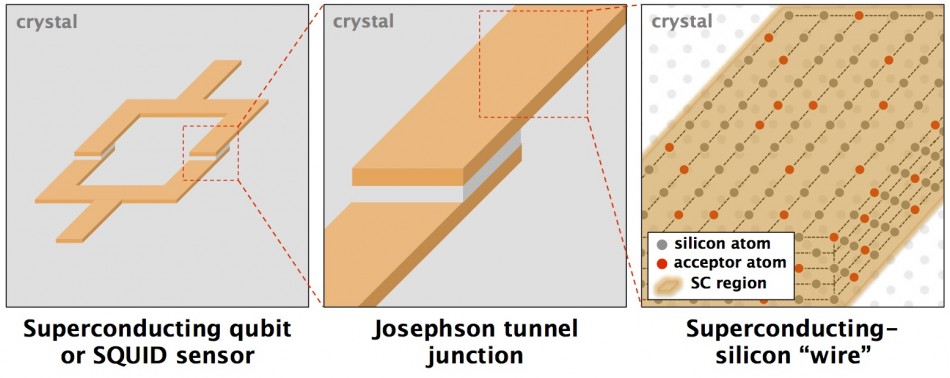Superconducting circuits are exceptionally flexible, enabling many different devices from sensors to quantum computers. Separately, epitaxial semiconductor devices such as spin qubits in silicon offer more limited device variation but extraordinary quantum properties for a solid-state system. It might be possible to merge the two approaches, making single-crystal superconducting devices out of a semiconductor by utilizing the latest atomistic fabrication techniques. Here we propose superconducting devices made from precision hole-doped regions within a silicon (or germanium) single crystal. We analyze the properties of this superconducting semiconductor and show that practical superconducting wires, Josephson tunnel junctions or weak links, superconducting quantum interference devices (SQUIDs), and qubits are feasible. This work motivates the pursuit of “bottom-up” superconductivity for improved or fundamentally different technology and physics.

Examples of superconducting-silicon quantum devices. (left) A superconducting loop interrupted at two points by junctions can form a superconducting flux qubit or a superconducting quantum interference device, or SQUID. Currents flowing in the loop can be used to measure the strength of a magnetic field threading the loop. The currents (flowing in either direction) can also be used to constitute a qubit. (middle) Separating the superconducting wires by an insulator, in this case pure, crystalline silicon, forms a Josephson junction. (right) Precisely placed, highly doped regions within the semiconductor form the superconducting wires.
Recent improvements in materials growth and fabrication techniques may finally allow for superconducting semiconductors to realize their potential. Here we build on a recent proposal to construct superconducting devices such as wires, Josephson junctions, and qubits inside and out-of single crystal silicon or germanium. Using atomistic fabrication techniques such as STM hydrogen lithography, heavily-doped superconducting regions within a single crystal could be constructed. We describe the characteristic parameters of basic superconducting elements—a 1D wire and a tunneling Josephson junction—and estimate the values for boron-doped silicon. The epitaxial, single-crystal nature of these devices, along with the extreme flexibility in device design down to the single-atom scale, may enable lower-noise or new types of devices and physics. We consider applications for such super-silicon devices, showing that the state-of-the-art transmon qubit and the sought-after phase-slip qubit can both be realized. The latter qubit leverages the natural high kinetic inductance of these materials. Building on this, we explore how kinetic inductance based particle detectors (e.g., photon or phonon) could be realized with potential application in astronomy or nanomechanics. We discuss super-semi devices (such as in silicon, germanium, or diamond) which would not require atomistic fabrication approaches and could be realized today.
arXiv: Superconducting-semiconductor quantum devices: from qubits to particle detectors